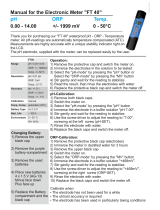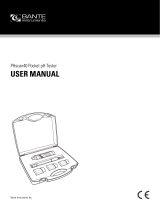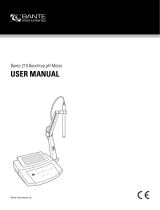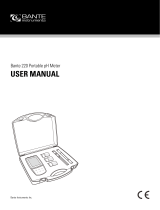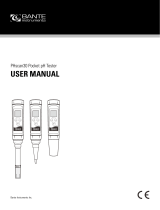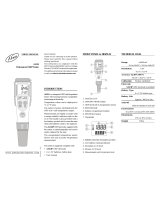Page is loading ...

Operating Manual
pHTestr
®
30 Pocket Testers
Keypad Functions
Short press = <2 seconds Long press = >2 seconds
1. Short press to turn on the tester and long press to turn
off the tester.
2. When turned off, long press to enter parameter setting
mode.
3. In measurement mode, short press to turn on backlight.
1. In measurement mode, short press to switch
parameter from pH to ORP (Oxidation Reduction
Potential); ORP probe sold separately.
2. In parameter setting mode, short press to change
parameter (unidirectional).
1. Long press to enter calibration mode.
2. In calibration mode, short press to confirm calibration.
3. When measured value is locked (HOLD icon), short
press to unlock.
CAL
<
MEAS
Thank you for purchasing an Oakton
®
pHTestr
®
Pocket pH Tester.
Please carefully read this operating manual before using the
product to obtain an accurate and reliable test result and avoid
unnecessary damage to the tester or sensor/probe.
Preparation Before Use
If it is first-time use or the tester hasn’t been used for a long
time,pour some 3M KCL solution to the Fill line in the probe cap and
soak the probe for about 15 to 30 minutes. Users can store the
probe in the 3M KCL solution in the probe cap when the tester is not in
use to maintain the sensor’s accuracy. To achieve maximum
accuracy, we recommend soaking the probe in the 3M KCL storage
solution overnight (12 hours) to activate the glassmembrane thoroughly.
Storing the pH30 tester dry will NOT cause any permanent damage.
It will only temporarily cause the probe to lose its sensitivity, which
can always be restored by soaking in the storage solution.
Calibration
1-point
2-point
3-point
USA series
7.00 pH
7.00 pH,
4.00 or
1.68 pH,
10.01 or
12.45 pH
NIST series
6.86 pH
6.86 pH,
4.01 or
1.68 pH,
9.18 or
12.45 pH
Indication
icons
M
L M H
Recommended
Accuracy:≥0.1 pH
7.00 pH,
4.00 pH or
1.68 pH
6.86 pH,
4.01 pH or
1.68 pH
L M
Range:<7.00 pH
7.00 pH,
10.01 pH or
12.45 pH
6.86 pH,
9.18 pH or
12.45 pH
M H
Range:<7.00 pH
Range:
0 to 14.00 pH
Symbol
Self-diagnostic
information
Checking and how to fix
1. Check whether pH buffer solution
is correct (1st point calibration
must be 7.00).
2. Check whether the probe is
damaged.
3. Check if there is any air bubble in
the glass bulb sensor.
Wrong pH buffer
solution or the range
of calibrationsolution
exceeds standard.
Press CAL/ key
when reading is not
stable during
measurement.
Wait for the measurement
stability icon (
) to appear and
stay, then press CAL/ key.
pH Calibration
1. Short press /MEAS key to turn on.
2. Rinse the probe in distilled water and use tissue paper to
gentlydab off excess water.
3. Pour certain amount (about half volume of the calibration bottles)
of pH 7.00 pH and pH 4.00 buffer solutions in the corresponding
calibration bottles.
4. Long press CAL/ key to enter calibration mode, short press /MEAS
key to return to measurement mode.
5. Dip the probe in pH 7.00 buffer solution, stir gently, and allow it to
stand still in the buffer solution until a
stable reading is reached. When
measurement stability icon (
) appears
and remains on the screen (see Fig 1);
then short press CAL/ key to complete
the one-point calibration. The tester
returns to measurement mode and
indication icon “M” will appear at the
bottom left of the screen, indicating the
middle point of calibration has been
completed.
6. For 2-point calibration, start with pH 7.00
buffer solution; once confirmed then rinse the probe in distilled
water and dry it with tissue paper. Dip the probe into pH 4.00
buffer solution, follow the steps above to complete 2-point
calibration. Indication icons “L” and “M” will appear on the bottom
left of the screen.
7. If necessary to perform a 3-point calibration, rinse probe with
water, dip the probe into pH 10.01 buffer solution (sold
separately), and follow the steps above. Indication icons “L”, “M”,
and “H” will appear on the bottom left of the screen.
Notes
A. Tester can perform 1 to 3 points automatic calibration. Please
note that pH 7.00 (USA Standard) or pH 6.86 buffer solution
(NIST Standard) must be used to conduct 1st point calibration.
Then use other buffer solution to conduct 2nd or 3rd point
calibration. Tester will automatically recognize five kinds of pH
buffer solutions. For details, please refer to the following table:
B. The buffer solutions poured into the calibration bottles are NOT
for one-time use. They can be used multiple times as long as
they are not contaminated, and the bottles are covered when not
in use. After that, we recommend replacing the buffer solutions in
the calibration bottles with new ones that are in the buffer bottles
(50 mL) to keep the accuracy of the standard buffer solutions. Do
not pour used buffer solutions back into the buffer bottles in case
of contamination.
C. The tester has self-diagnostic functions:
* The 1st point calibration must be 7.00 pH. Perform the 2nd point
calibration (4.00 pH) immediately after the 1st point. Do NOT turn
off the meter before you conduct 2nd point calibration. If the meter
is turned off after 1st point calibration, user will need to restart the
calibration process with the 7.00 pH first and the 4.00 pH following
after. Calibrating directly in pH 4.00 after turning meter off and
back on will cause “Er1”.
pH Measurement
1. Short press /MEAS key to turn on the tester. Rinse the probe in
distilled water, and gently dab off excess water with tissue paper
(do not rub or wipe the glass sensor).
2. Dip the probe in sample solution, stir gently, and allow it to stand
until a stable reading is reached. Take readings after stability
indicator icon (
) appears and stays on the screen.
Notes
A. Applications:
Model/Probe Application
pH30/Bulb probe
Regular water solutions’ pH measurement
such as hydroponics, aquaculture, pools and
spas, water treatment, brewing, etc.
Special Notes
• The pH probe must be rinsed thoroughly after each use. Soap
water should be used to clean off any grease or other
contaminants.
• These pH testers will NOT give accurate or stable pH readings
when testing distilled or deionized water. This is because distilled
or deionized water do not have enough ions present for the
electrode to function properly. To measure distilled or deionized
water’s pH, users need to use a specialized instrument technique.
When testing purified water like spring water or drinking water, it
will take longer for the readings to get stabilized (typically 3 to 5
minutes) because there are very few ions left to be detected by the
sensor in those purified water.
• Do NOT store probe in distilled or deionized purified water
because that will cause permanent damage to the pH probe.
Purified water is only recommended for rinsing the probe. The
probe should be stored in 3M KCL pH electrode storage solution
(SKU 00653-04) for best accuracy.
Setting the Parameters
When tester is turned off, long press /MEAS key to enter
parameter setting. Short press MODE/key to switch from P1 to
Features
• Large easy-to-read LCD with
3-color backlight
• Accuracy of ±0.01 pH ± 1 digit
• 1, 2, or 3 calibration points
• Auto buffer recognition: US or
NIST
• Stability and battery status
icons
• Replaceable double-junction
sensor saves your money
• Auto power-off function
conserves battery life
• IP67 waterproof rating
• No air bubbles generating in
blue gel inner solution
• Bulb protector can avoid
impacting. Remove it to rinse
the probe.
Bulb
protector
It's detachable
to rinse the
probe.
P2…P7. Short press CAL/ key and parameter will flash, then short
press MODE/key to choose desired parameter. Short press
CAL/ key to confirm parameter selection. Long press /MEAS key
to return to measurement mode.

www.4oakton.com
June 2019
1065O101_MAN_pH30_35634-30
Symbol Menu setting Selection Factory default
P1
P2
P3
P4
P5
P6
P7
Select pH buffer
solution
Set low
measurement alarm
Set high
measurement alarm
Select Automatic
Lock (HOLD)
Select backlight
Select temperature
unit
Restore to factory
default
USA – NIST
0 to 14.00 pH
Off – On
Off – 1 – On
°C – °F
No – Yes
USA
0 to 14.00 pH 0
14.00
Off
1
°C
No
Setting the Parameters
When tester is turned off, long press /MEAS key to enter
parameter setting. Short press MODE/key to switch from P1 to
Notes
A. Select standard pH buffer solution (P1) There are two options of
standard buffer solutions: USA series and NIST series.
B. High and Low Measurement Heads-Up Examples (P1 and P2)
Alert when measured value ≤3.20 pH: Preset lowest value (P2) = 3.20
pH, highest value (P3) = 14.00 pH, when measured value is ≤3.20
pH (stability icon (
) displays on LCD), the red backlight appears on
display.
Alert when measured value ≥8.60 pH: Preset highest value (P3) = 8.60
pH, lowest value (P2) = 0.00 pH, when measured value is ≥8.60 pH
(stability icon (
) displays on LCD), the red backlight appears on
display.
Alert when measured value ≤3.20 pH or ≥8.60 pH: Preset lowest
value (P2) = 3.20 pH, highest value (P3) = 8.60 pH, when measured
value is lower than 3.20 pH or higher than 8.60 pH (stability icon (
)
displays on LCD), the red backlight appears on display.
C. Automatic Lock (P4)
Select “On” to activate auto lock function. When reading is stable for
more than 10 seconds, the tester will lock the value automatically,
and “HOLD” icon will appear on the bottom left of the screen. Press
CAL/ key to cancel HOLD on reading.
D. Backlight (P5)
Select “Off” to turn off backlight function, “On” to turn on backlight
unction, or “1” to have backlight last for 1 minute.
E. Temperature Unit (P6)
Select °C or °F; the factory default is °C.
F. Factory Default Setting (P7)
Select “Yes” to recover instrument calibration to the theoretical value
(pH value in zero potential is 7.00 pH, slope is 100%), parameter
setting returns to initial value. This function can be used when
instrument does not work properly in calibration or measurement.
Calibrate and measure again after resetting the unit to factory
default status.
ORP Measurement
ORP stands for Oxidation-Reduction Potential. ORP is a measure of
the cleanliness of the water and its ability to break down
contaminants. Note that ORP sensor module 35634-58 or 35634-68
must be purchased separately (see Ordering Information).
Once ORP sensor probe is attached to tester, press MODE/key to
enter ORP mode. Rinse the probe in distilled water and dry it. Dip
the probe in sample solution, stir gently, and allow it to stand still
until a stable reading is reached. Get readings after measurement
stability icon (
) appears and remains on the screen.
pH
ORP (mV)*
Temperature
Range
Resolution
Accuracy
–2.00 to 16.00 pH
0.01 pH
±0.01 pH ±1 digit
Calibration points
1, 2, or 3 points;
auto buffer recognition
Automatic
temperature
compensation
(ATC)
32 to 122°F(0 to 50°C)
Range ±1000 mV
Accuracy ±0.2% full-scale
Resolution 1 mV
Range
Resolution
Accuracy
32 to 122°F (0 to 50°C)
0.1°F/°C
±0.9°F (0.5°C)
Specifications
* Note that the ORP probe 35634-58 or 35634-68 must be purchased
separately (see Ordering Information).
Display: LCD with three-color backlight. Blue = measurement;
Green = calibration; Red = alarm
Reading lock: HOLD icon
Power: four AAA batteries (included); >400 hours of continuous
operation
Low-voltage warning: battery status icon flashes
Auto power-off: tester automatically turns off after 8 minutes of
nonuse
IP rating: IP67 (waterproof), floats on water when sensor cap is on
Dimensions (L x W x H): 7" x 1.5" x 1. 5" (17.8 x 4 x 4 cm)
Weight: 4.7 oz (133 g)
Probe Replacement
Screw off the probe/sensor ring, unplug the probe, plug in the new
replacement probe (pay attention to the probe’s position), and
rescrew on the sensor ring.
Battery Installation
The tester uses four AAA batteries. Please install batteries accor ing
to the following steps. Note the correct direction of battery installa-
tion: the positive side (+) of every single battery must face up.
Incorrect installation of batteries will cause damage to the tester and
create a potential hazard.
Warranty
We warrant this instrument to be free from defects in material and
workmanship and agrees to repair or replace free of charge, at
option of Oakton Instruments, any malfunctioned or damaged
product attributable to responsibility of Oakton Instruments, for a
period of two years from the delivery (a six-month limited warranty
applies to sensors). This warranty does not apply to defects
resulting from actions such as misuse (violation of the instructions in
this manual or operations in the manner not specified in this
manual), improper maintenance, and unauthorized repairs.
Warranty period is the time limit to provide free service for the
products purchased by customers, not the service life of the tester
or probe.
Oakton Instruments reserves the right to update the information in
this manual without giving notice in advance.
Model
Catalog
number
Product description
pH30 pHTestr 30 pocket pH tester
Replacement sensor for pHTestr 30
Optional probe/sensor for ORP testing
(single junction)
Optional probe/sensor for ORP testing
(double junction)
35634-30
35634-03
35634-58
35634-68
Ordering Information
—
—
—
Cap Lock Clip
Battery Lid
Lift the clip to unlock
4×AAA
Batteries
Push the clip to open the battery lid
1. Open battery lid.
2. Slide the battery cap along the direction of arrow.
3. Open the battery cap.
4. Insert the batteries (ALL POSITIVE SIDES FACING UP).
5. Close the battery cap.
6. Slide and lock the battery cap along the direction of arrow.
7. Fit the tester’s cap while making sure to push all the way down.
The tester’s waterproof design may be compromised if the cap is
not fitted correctly.
P2…P7. Short press CAL/ key and parameter will flash, then short
press MODE/key to choose desired parameter. Short press
CAL/ key to confirm parameter selection. Long press /MEAS key
to return to measurement mode.
/
